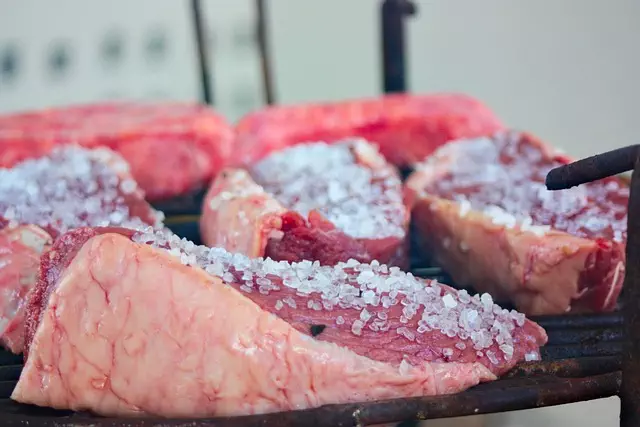This overview compares Bali Kratom Capsules and Kratom tea, highlighting their distinct advantages. Capsules offer a precise, user-friendly dosage form, harnessing the alkaloids mitragynine and 7-hydroxymitragynine found in Indonesian forests. In contrast, making Kratom tea at home provides users with greater control over dosage and a unique sensory experience due to different alkaloid extraction dynamics. The 'best way to make kratom tea' involves boiling leaves or capsules in water, which extracts the alkaloids differently than capsules, resulting in a distinct effect profile. This method also allows for personalization of flavor and potency, with some users reporting a longer-lasting sensation from the tea form. The choice between capsules and tea comes down to personal preference, with factors like convenience, taste, and desired intensity playing a role. Consumers should consider their individual needs, the setting in which they will use Kratom, and adhere to local regulations when making their decision. Regardless of the method chosen, maintaining recommended dosages is crucial for a safe experience.
Discover the nuanced world of Bali Kratom Capsules, a potent botanical supplement gaining popularity for its myriad effects. This article serves as your definitive guide, illuminating the potency encased within each capsule and providing insights into alternative consumption methods. Delve into the intricate process of brewing Bali Kratom Tea, known for its unique benefits and often sought after as the best way to make kratom tea. We’ll compare the efficacy, experience, and preferences between capsules and tea, offering a balanced view for enthusiasts to make an informed choice. Join us on this exploration of Bali Kratom’s diverse consumption options.
- Unveiling the Potency of Bali Kratom Capsules: A Comprehensive Guide
- Mastering the Art of Kratom Tea: An Alternative to Capsules with a Step-by-Step Process
- Comparing Capsules and Tea: Pros, Cons, and Personal Preference in Bali Kratom Consumption
Unveiling the Potency of Bali Kratom Capsules: A Comprehensive Guide
Discovering the potency of Bali Kratom Capsules requires a nuanced understanding of their alkaloid composition and how these interact with the human body. Bali Kratom, sourced from the lush forests of Indonesia, is renowned for its distinctive effects, which are often attributed to the specific strain’s unique alkaloid profile. The capsules encapsulate the raw leaves, preserving a significant concentration of mitragynine and 7-hydroxymitragynine, the primary active compounds responsible for Bali Kratom’s effects. For those seeking an alternative to the traditional leaf consumption, these capsules offer a precise and convenient dosage form, making them a popular choice among users.
When considering the best way to make kratom tea as an alternative to capsules, it’s important to note that this method allows for greater control over the dosage and can provide a different experience due to the alkaloids being extracted differently compared to when they are encapsulated. The tea-making process involves boiling the leaves or crushed capsules in water, which releases the active compounds into the liquid. This extraction technique can yield a different alkaloid profile than what’s found in the capsules, potentially affecting the onset and duration of effects. Whether choosing capsules for their convenience or opting for tea to tailor the experience, understanding the intricacies of kratom’s properties is key to making an informed decision that aligns with your preferences and needs.
Mastering the Art of Kratom Tea: An Alternative to Capsules with a Step-by-Step Process
Kratom enthusiasts often explore various consumption methods, and among these, kratom tea stands out as a gentle yet potent alternative to capsules. Brewing kratom tea can be an art form that offers a unique experience compared to ingesting capsules. The best way to make kratom tea involves a few precise steps to ensure both the flavor and the effects are optimized. Begin with fresh, high-quality kratom leaves or powder; it’s crucial to source from reputable vendors to ensure potency and safety. To start, measure out the desired amount of kratom powder and place it in a tea infuser or a muslin bag to contain it during the brewing process.
Boiling water should be poured over the kratom-containing infuser or bag, and it should be allowed to steep for about 10 to 15 minutes. This duration is critical as it allows the alkaloids within the kratom to infuse into the water fully. During this time, the tea will develop a rich, earthy flavor that many tea aficionados come to appreciate. After steeping, remove the infuser or bag and compost the leaves, if possible, as they have given their essence to the brew. The resulting tea can be enjoyed hot or cooled for iced kratom tea. Adjusting the brewing time and temperature can influence the potency and effects, so experimentation may be necessary to find the best method that suits your individual preferences. This traditional approach to consuming kratom offers a natural and straightforward alternative to capsules, providing a smooth and controlled experience.
Comparing Capsules and Tea: Pros, Cons, and Personal Preference in Bali Kratom Consumption
When considering Bali Kratom consumption, the choice between capsules and tea presents distinct advantages and drawbacks for users. Capsules offer a convenient, pre-measured dosage form that eliminates the need for precise measurement or the bitterness often associated with Kratom tea. The encapsulation process ensures a consistent dose, which is ideal for individuals seeking a straightforward and controlled experience. Additionally, capsules are portable and discreet, allowing users to consume Bali Kratom on-the-go without the paraphernalia typically required for brewing tea.
On the other hand, Kratom tea aficionados might argue that the traditional method of preparation, often referred to as the ‘best way to make kratom tea,’ offers a more authentic experience. Brewing Bali Kratom as tea can yield a smoother and subtler effect compared to capsules, which some users find preferable for relaxation or enhanced focus. The tea form also allows for ingredient adjustments based on taste preferences and desired potency. Moreover, the length of effects from tea might differ from capsules, with some users reporting a more gradual onset and longer-lasting sensation when consuming Kratom in its leaf form. Personal preference plays a significant role in this decision; some individuals may find the convenience and consistency of capsules most appealing, while others may prioritize the sensory experience and potential for fine-tuning the effects through the tea method. Regardless of the chosen consumption method, it is crucial to adhere to recommended dosages and local regulations regarding Kratom use.
Exploring the intricate world of Bali Kratom Capsules has shed light on their potency and effectiveness, providing readers with a clear understanding of their potential benefits. This exploration also extended to the time-honored tradition of crafting Kratom tea, offering an alternative method for consumers to experience its effects. Through comparing capsules to tea, it’s evident that both forms have unique advantages and drawbacks, allowing individuals to make an informed choice based on personal preference. For those interested in the best way to make kratom tea, the guide provided ensures that enthusiasts can now enjoy this botanical’s attributes with precision and care. In closing, whether opting for capsules or brewing a cup of Kratom tea, users are encouraged to approach their experience with mindfulness and respect for the substance’s powerful nature.






